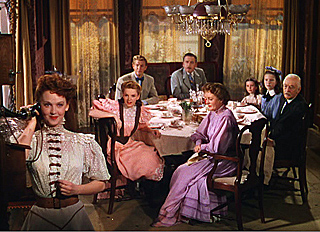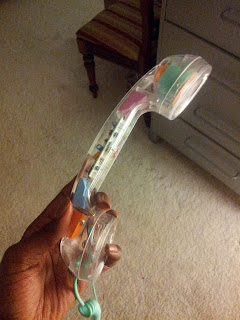Yes, yes, the good ole days!
Hello Guys and Dolls! Hope all is well with you and yours! I'm sooo exited about this weeks topic because it has to do with things of time. And one thing about me, I'm a vintage girl ALL the way, I have a major appreciation for classic things- I get it from my momma :-)
Take a quick look below at exhibit A:
 |
| Oh yes!! (See that face?!) |
 |
| *dreamy* |
...Yes, I'm a hopeless romantic! It's true :-)
 |
| Scene from "Meet Me in St. Louis." Penny talking to her long distance love in NY |
Vintage phones, where did it all began?? Lets take a look at the evolution of the telephone.
Telephone prehistory
Mechanical devices
Among the earliest known experiments were those conducted by the British physicist and polymath Robert Hooke from 1664 to 1685.[1][3] An acoustic string phone made in 1667 is attributed to him.[4]
For a short period of time acoustic telephones were marketed commercially as a niche competitor to the electrical telephone, as they preceded the latter's invention and didn't fall within the scope of its patent protection. When Alexander Graham Bell's telephone patent expired and dozens of new phone companies flooded the marketplace, acoustic telephone manufacturers could not compete commercially and quickly went out of business. Their maximum range was very limited, but hundreds of technical innovations, resulting in about 300 patents, increased their range to approximately a half mile (800 m) or more under ideal conditions.[2] An example of one such company was the Pulsion Telephone Supply Company created by Lemuel Mellett in Massachusetts, which designed its version in 1888 and deployed it on railroad right-of-ways.
Additionally, speaking tubes have long remained common, including a lengthy history within buildings and aboard ships, and can still be found in use today.[5]
Electrical devices
Main article: Electrical telegraph
The telephone emerged from the creation of, and successive improvements to the electrical telegraph. In 1804 Catalan polymath and scientist Francisco Salva Campillo constructed an electrochemical telegraph.[6] An electromagnetic telegraph was created by Baron Schilling in 1832. Carl Friedrich Gauß and Wilhelm Weber built another electromagnetic telegraph in 1833 in Göttingen.The first commercial electrical telegraph was constructed by Sir William Fothergill Cooke and entered use on the Great Western Railway in England. It ran for 13 miles from Paddington station to West Drayton and came into operation on April 9, 1839.
Another electrical telegraph was independently developed and patented in the United States in 1837 by Samuel Morse. His assistant, Alfred Vail, developed the Morse code signaling alphabet with Morse. America's first telegram was sent by Morse on January 6, 1838, across two miles of wiring.
During the second half of the 19th century inventors tried to find ways of sending multiple telegraph messages simultaneously over a single telegraph wire by using different modulated audio frequencies for each message. These inventors included Charles Bourseul, Thomas Edison, Elisha Gray, and Alexander Graham Bell. Their efforts to develop acoustic telegraphy in order to significantly reduce the cost of telegraph messages led directly to the invention of the telephone, or 'the speaking telegraph'.
Invention of the telephone
Main article: Invention of the telephone
Credit for the invention of the electric telephone is frequently
disputed, and new controversies over the issue have arisen from
time-to-time. Charles Bourseul, Antonio Meucci, Johann Philipp Reis, Alexander Graham Bell, and Elisha Gray,
amongst others, have all been credited with the telephone's invention.
The early history of the telephone became and still remains a confusing
morass of claims and counterclaims, which were not clarified by the huge mass of lawsuits to resolve the patent
claims of many individuals and commercial competitors. The Bell and
Edison patents, however, were commercially decisive, because they
dominated telephone technology and were upheld by court decisions in the
United States.The modern telephone is the result of work of many people.[7] Alexander Graham Bell was, however, the first to patent the telephone, as an "apparatus for transmitting vocal or other sounds telegraphically". Bell has most often been credited as the inventor of the first practical telephone. However, in Germany Johann Philipp Reis is seen as a leading telephone pioneer who stopped only just short of a successful device, and as well the Italian-American inventor and businessman Antonio Meucci has been recognized by the U.S. House of Representatives for his contributory work on the telephone. Several other controversies also surround the question of priority of invention for the telephone.
The Elisha Gray and Alexander Bell telephone controversy considers the question of whether Bell and Gray invented the telephone independently and, if not, whether Bell stole the invention from Gray. This controversy is narrower than the broader question of who deserves credit for inventing the telephone, for which there are several claimants.
The Canadian Parliamentary Motion on Alexander Graham Bell article reviews the controversial June 2002 United States House of Representatives resolution recognizing Meucci's contributions 'in' the invention of the telephone (not 'for' the invention of the telephone). The same resolution was not passed in the U.S. Senate. thus labeling the House resolution as "political rhetoric". a subsequent counter-motion was unanimously passed in Canada's Parliament 10 days later which declared Bell its inventor. This webpage examines critical aspects of both the parliamentary motion and the congressional resolution.
(More Info)
Okay! Enough with the technical talk, let's really look at the evolution!
1920's

Switch Board History
Model 50AL
Candlestick
This desk set was the first free-standing dial telephone and was introduced in 1919.
It began an era of rotary dial telephone sets which would span the rest of the 20th century.

 |
| Original "Imitation of Life" |

 |
| "It's A Wonderful Life" (One of my favorite Christmas movies!!!) Intense call! Love this little scene |

No seriously!! How cool is this??! I want this!!
Moving Right along!
1930's
In 1927, Western Electric produced its first model
to use a handset, making it easy for the subscriber
to use the telephone while keeping a hand free for
taking notes or performing other tasks.
The A1 was built upon the base of the 51AL candlestick. The post was shortened and a cradle with modified switch hook was added.
 |
| "Breakfast at Tiffanys" The beautiful Ms. Hepburn!! |
 |
| Mrs. Garland any one??!!! |
So base same but top changed, hmm..interesting
NEXT
1940's
Model 302
In 1937, Western Electric and the Bell System introduced the 302, created by the renowned industrial designer, Henry Dreyfuss. The shell of the 302 was intended to be cast out of metal. However, in 1941, the critical war-time need for metal caused Western Electric to retool to make the 302 out of molded thermoplastic.
The 302 was the first telephone containing all of its circuitry within the base and not requiring a separately mounted apparatus box for the ringer.
.jpg) | ||
| Daddy Warbucks on broadway |
 | |||||
| LOVE IT!!!! Check out that baby she's on :-) VINTAGE YAY! |

1950's
Model 500
First introduced in 1949, the Model 500 was to become the standard Bell System telephone for well over a generation and the most widely produced dial telephone ever.
Like the 5302, the dial markings were placed outside of the fingerwheel holes for improved legibility. The slightly larger base provided room inside the 500 for an adjustable bell ringer and enhanced electronics. The more angular G1 handset design replaced the curves of the 1930-looking F1.
Since the 1930s, Western Electric had manufactured telephone sets in colors. However, only the most affluent were willing to pay the substantial extra monthly charge for having a phone that wasn't basic black. In the early 1950s, the Bell System began to promote the new 500 sets in "designer colors" for an affordable one-time non-recurring charge at the time of installation. The basic black 302 was quickly upstaged by 500 sets in lemon yellow, harvest gold, chocolate brown, rose pink, cherry red, lime green, avocado, turquoise and more than a dozen other colors.

 | ||||
| Naomi!! Rock that vintage shoot!! She is fierce in ALL things!! |
Next stop?!
1960's
So interesting right??!!
Over the years I've picked up two little items that give me the vintage telephone feel and I'm looking forward to purchasing even more. Growing up, dad had one just like this!
and then later I found this at a thrift store
 | ||
| Just for show though, this isn't a real telephone |
And then later, my good friend James Murphey got me this to go with my cell phone!
I 'll love him forever for this!!!
Get yours today!!
Urban Outfitters
Welp! Thats all folks, it's been a pleasure as always :-)
Thank you for reading!!
-M.K.Ngenge #fineline

















.jpg)
























No comments:
Post a Comment